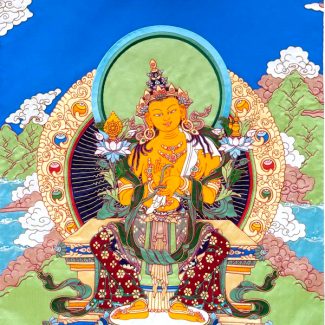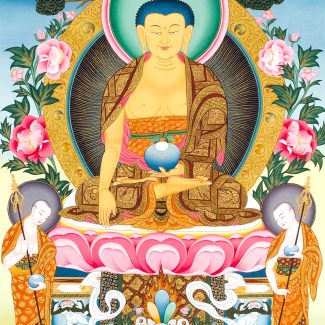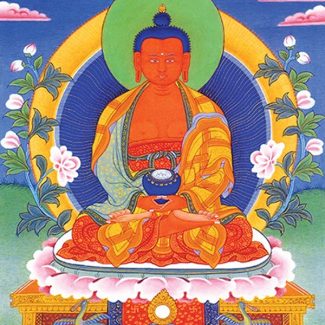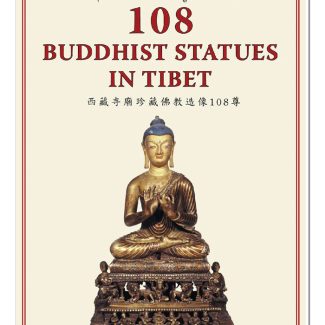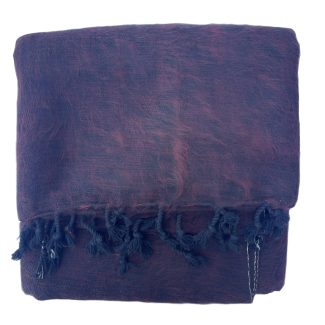Artists traditionally create Buddha Thangkas, which are Tibetan Buddhist paintings. These paintings show Buddha, other important figures, symbols, and scenes, based on Buddhist teachings. In fact, artists usually create such works of art on cloth, using vivid colors and small details, since they consider them sacred in nature.
People use Thangkas for meditation and as visual aids when teaching Buddhist philosophy and spirituality. They can show a range of things, from calm Buddha portraits to complex mandalas. People use each of these for reflection and devotion, and each holds a deep spiritual meaning.
Shakyamuni Buddha Thangka Painting
$ 10.00
Sometimes referred to as Shakyamuni, Siddhartha Gautama Buddha was the spiritual teacher from whom Buddhism emanated. He is considered the first enlightened being to be visualized and regarded as the Supreme Buddha.
The Shakyamuni Buddha thangka is, besides being very beautiful, very powerful spiritually: it will grow compassion, wisdom, and peace in life when memory from the Buddha keeps reminding. Being a very propitious addition for a new office or any home or any mediation venue, this artwork will generate that calm environment with the feel inside that creates reflections and spiritual advancement.
Approximate size: 25x35cm
White Tara Thangka Painting
$ 10.00
In Tibetan Buddhism, White Tara, also called Female Buddha, is the mother of all Buddhas and the goddess of healing and compassion. The soles of her feet are shown facing upward as she sits in lotus pose.
White Tara, also known as Saraswati, is linked to longevity. White Tara helps to promote a long life by combating sickness. It is believed that giving a newborn a thangka painting of White Tara will bring good fortune and a long life.
Approximate Size: 25x35cm
Vajrasattva Thangka Painting
$ 10.00
Vajrasattva is one of the highest deities in Buddhism, especially in Vajrayana Buddhism, worshipped for purification or removal of spiritual impurities.
This Vajrasattva Thangka is a work of art and a tool of the sacred for your further spiritual growth. Whether used in meditation, on your altar, or hung in your house, it serves as a powerful reminder of the importance of compassion, knowledge, and purity on the path to enlightenment.
Approximate Size: 25x35cm
Medicine Buddha Thangka
$ 10.00
Medicine Buddha as depicted here is also known as Bhaisajyaguru Vaidurya Prabha. He is the Healing Master of Vajrayana. He is often called the “Medicine Buddha” and is characterized as a physician who uses the medication of his teachings to treat Suffering, or pain.
Meditation in front of the Medicine Buddha thangka will reduce physical and mental stress, improve their healing powers for themselves as well as others, and finally overcome spiritual sickness, attachment, hatred, and ignorance.
Approximate size: 25x35cm
Guru Rinpoche Thangka Painting
$ 10.00
Guru Rinpoche is called “precious master” in Tibetan and is also called Guru Padmasambhava. Guru Rinpoche was a progressively enlightened man who gained his spiritual understanding without needing to follow Buddha Shakyamuni. He is the epitome of both kindness and strength, knowing when to use force and when to be kind.
His ability to guide others toward spiritual awareness stems from his mastery of both faculties. His inclusion in this potent work of art demonstrates the unique insight he possesses in guiding people toward spiritual enlightenment and is certain to benefit any area it adorns.
Approximate Size: 25x35cm
Green Tara Thangka Painting
$ 10.00
Tara is a manifestation of Chenrezi, the Bodhisattva of Compassion, according to the tale. Chenrezi once cried twice because he was so moved by the suffering of all sentient beings. His right eye’s tear transformed into Tara’s green shape, while his left eye’s tear changed into Tara’s white form.
The practice of Tara, a meditation deity, is thought to help cultivate inner traits and comprehend inner, inner, and hidden teachings about emptiness and compassion.
Approximate Size: 25x35cm
Four Arms Chengregic Thangka Painting
$ 10.00
Chenrezig is the Bodhisattva of Compassion, one of the most revered gods in the Buddhist pantheon. This much-cherished figure has been revered everywhere in the Buddhist world and is believed to embody the compassion of all Buddhas.
Meditating upon a Chenrezig Thangka gives us access to this boundless compassion of the holy entity and helps us in developing more empathy and compassion in life.
Approximate Size: 25x35cm
Maitreya Thangka Painting
$ 199.00
Maitreya is the loving kindness Bodhisattva and Buddha of the future. He is the successor of Shakyamuni Buddha and he will come to this world to teach the pure dharma. Currently Maitreya lives as Bodhisattva in the Tuṣita Heaven, the same place where Gautama Buddha lived before coming to this world.
This Maitreya Buddha Thangka serves as more than just a beautiful work of art. It is a symbol of hope, loving-kindness, and wisdom, making it the perfect addition to your spiritual practice or living space. May the blessings of Maitreya Buddha inspire compassion and enlightenment in your life.
Shakyamuni Buddha Thangka Painting
$ 390.00
Sometimes referred to as Shakyamuni, Siddhartha Gautama Buddha was the spiritual teacher from whom Buddhism emanated. He is considered the first enlightened being to be visualized and regarded as the Supreme Buddha.
The Shakyamuni Buddha thangka is, besides being very beautiful, very powerful spiritually: it will grow compassion, wisdom, and peace in life when memory from the Buddha keeps reminding. Being a very propitious addition for a new office or any home or any mediation venue, this artwork will generate that calm environment with the feel inside that creates reflections and spiritual advancement.
Amitabha Buddha Thangka Painting
$ 199.00
One of the most important of the five cosmic figures of Himalayan Esoteric Buddhism is Amitabha, also called Amitayus Buddha. Amitabha Buddha has manifested as the bodhisattva Avalokiteshvara and the historical Buddha Gotama. Amitabha has great spiritual significance as the head of the Padma family, one of the Five Directional Buddhas.
Amida in Japanese, Amita in Korean, A-di-da in Vietnamese, Am-mi-to in Chinese, and Amideva in Tibetan chants are some of the names used to refer to Amitabha in different cultures. In observance of his divine presence, his followers commemorate his birth on the seventeenth day of the eleventh lunar month.








